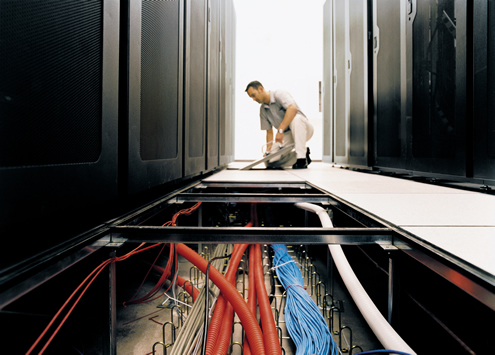Data center Cabling
Data center Cabling
Structured cabling involves the connectivity of different smaller elements that specify the wiring for data centers, offices, and buildings using various kinds of cables adhering to specified standards. These standards define the layout of the cables according to the requirements of the clients and the data center as a whole.
Data centers and storage area networks are the fastest growing streams of technology in the IT sector. It has been reported by a recent study that the growth and retention requirements of these centers have gone up by 50% this year. This type of growth is governed by various legislative agreements on how much data is to be stored and for how long.
Cabling of a data center needs to adhere to different standards of specification. Amongst them the most important standard that one needs to know for structured cabling is the TIA standard.
The TIA standard specifies the minimization of design and management of structured cabling within data centers.
Before analyzing the TIA standard, it is important that we understand the need for structured cabling for a data center.
Need for structured cabling
Most of the time data centers and SANs are constructed without having considered the implications of frequent additions, moves, and expansions. Some systems like the computers and single physical servers are normally installed by the company’s own technicians and crew. This crew is competent when it comes to the perspective of their own equipments. But the data centers house in them varied, disparate equipments, and data storage devices. Using such practices inevitably causes inefficient management of critical conditions. Critical conditions could range from advancement in technology to the addition of new products and services.
In the early years, a wide variety of cabling and architecture were common, but difficult to manage. This form of undesirable situation lead to the formation of the TIA/EIA-568 Commercial Building Cabling Standard, which eventually changed the way cabling for commercial buildings, telecommunication sectors, and data centers were done. This introduced a new and modernized way of cabling that is the ‘structured cabling’.
Many cable and copper industries developed new connectivity products that dramatically offered advantages to the data centers and SANs. Most of the experts and their successors, who developed the TIA-568 and its next called the TIA-568a, developed another standard called the SCS.
The TIA-568 was designed to suit the requirements of commercial buildings.
The TIA-942, Telecommunication Infrastructure Standard for data centers is bound to have immense effect on the data center and SAN as profoundly as the TIA 568 has on commercial buildings.
This new standard allows the SCS concepts to be implemented in the disparate equipments very early in the building design process. This particular standard views the whole data center as an integrated system with smaller ancillary elements. As a result, it interlinks many components like location, access along with architecture and electrical components to a most important concept of redundancy.
The TIA 942 includes seven spaces and two cabling subsystems within the data center.
- Ø Seven spaces include-
- Computer room
- Telecommunications room
- Entrance room
- Main Distribution Area(MDA)
- Horizontal Distribution Area( HDA)
- Zone Distribution Area( ZDA)
- Equipment Distribution Area (EDA)
The cabling subsystems in TIA 942 include the horizontal and backbone.
The first five spaces generally involve many connections like high density panels and racks using fiber connectors like LC. The entrance room is the interface within the campus and is similar to the entrance room of a commercial building. MDA is the area where the main cross connect is located. HDA houses the horizontal cross connect. ZDA is an optional space and is where the zone outlet is located. EDA is where the cabinets, servers, and racks are located. It is similar to the working area of a commercial building.
Data Center Talk updates its resources everyday. Visit us to know of the latest technology and standards from the data center world.
Please leave your views and comments on DCT Forum

